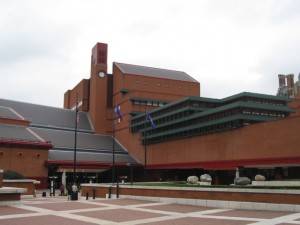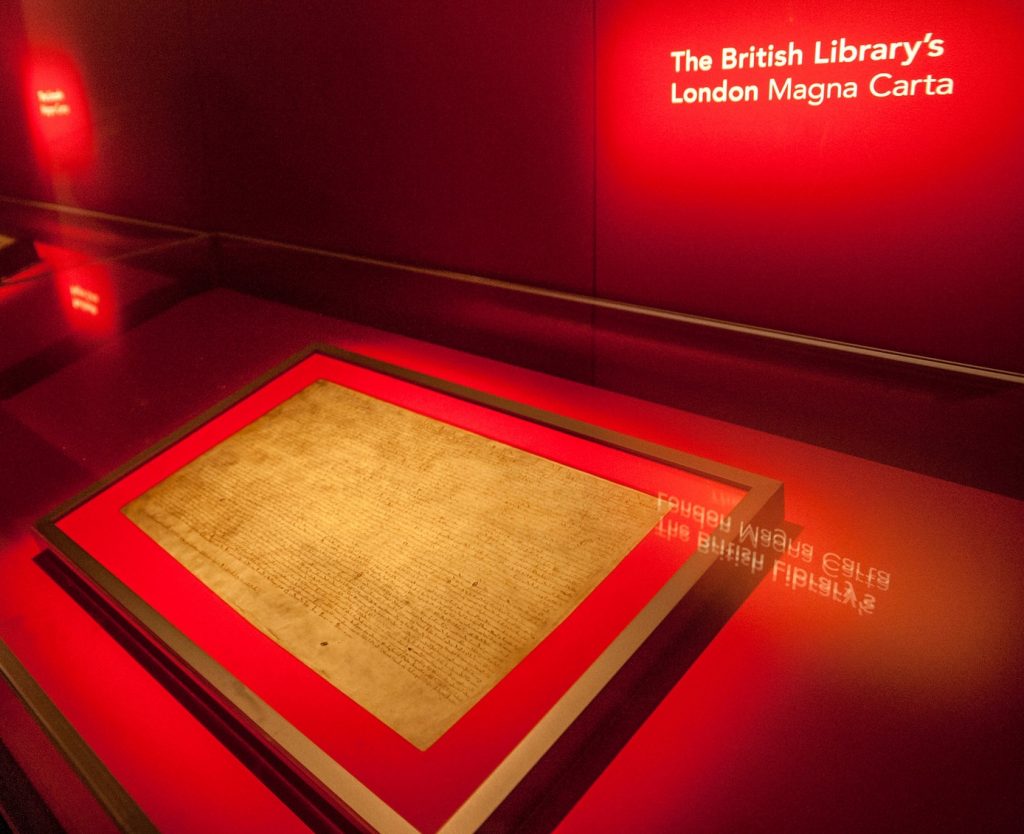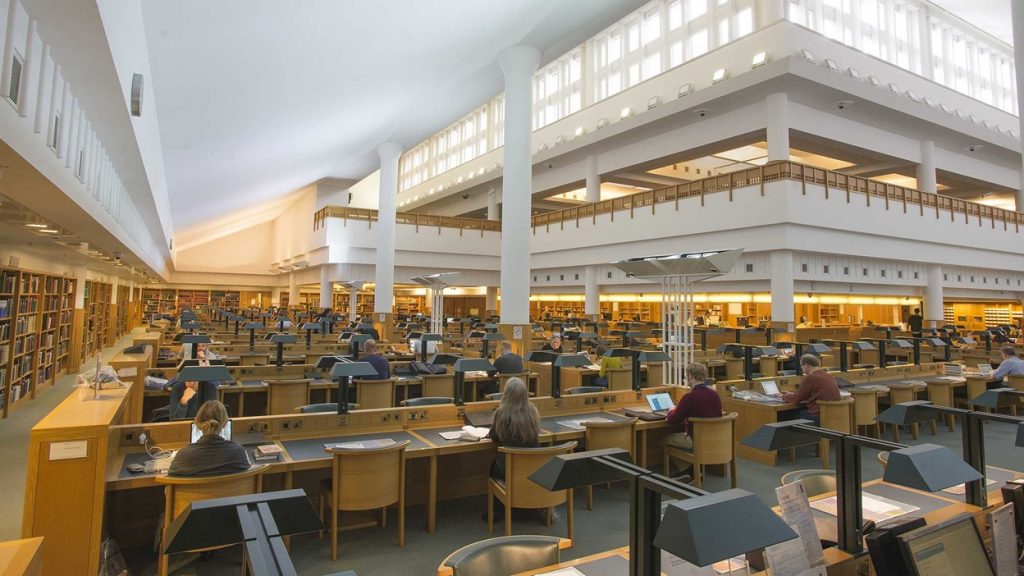


For the special library category of our library visits assignment, I chose to do a virtual visit of the British Library’s special collections exhibit entitled Treasures of the British Library. I chose this library in London because my previous (in-person) visit had a profound effect on me, and was very awe-inspiring. I hope to revisit the library and share this experience with my family when we travel to England this summer.
For those working in the library field, the British Library represents a pinnacle of greatness. According to their website, “spanning nearly 3,000 years, the British Library holds over 150 million items representing every age of written civilization. As well as books, you’ll find illuminated manuscripts, maps, stamps, photographs, music and much more” (https://www.bl.uk/). The Treasures of the British Library special collections exhibit specifically is worth a visit because it highlights the best of the library’s literary, scientific, music, art and sacred texts collections, and will help viewers “discover the stories that have shaped the world” (https://www.bl.uk/events/treasures-of-the-british-library). In recent years there has been an increased focus on including works by women, such as the Art of the Book: a display of female artists, works and artifacts from female authors (including the writing desk and eyeglasses of Jane Austen), and journals of scientific research (including one set hand written by Florence Nightingale). For history enthusiasts, an essential display to view is Magna Carta, two copies of which are in the collection at the British Library. For music aficionados, there are works by many artists, ranging from Mozart to McCartney. Our textbook points out that special collections libraries are similar to other types of libraries in that “rather than serving primarily as a physical place where information is stored, the special library is activity-oriented, focusing on meeting users’ information needs” (Rubin & Rubin, 2020, p. 199). They elaborate further, saying “special libraries must align closely with the goals and strategic directions of the larger organization and its units. Special librarians must position themselves effectively within the organization as a whole” (Rubin & Rubin, 2020, p. 201). The Treasures of the British Library is a stellar example of a special library collection meeting these criteria, and doing so with an eye to the past, present, and future.
The British Library in London is a very imposing building, full of cultural history and significance. It is most convenient to arrive there on public transport, everything is clearly signed in multiple languages, and there are shops and cafes on the premises. It is easy to feel overwhelmed and intimidated by the British Library, and difficult to view as a typical library. In their essay “Encoding Spaces”, the authors state, “If we want to elevate the way people feel when they use the library, we need to elevate the way they feel about the library itself. We need to create environments that stimulate an emotional connection” (Mathews & Stoistmann, 2020). The emotional connection I felt at the British Library was immediate, and one of awe and respect. There is a large gated courtyard that leads into a high-ceilinged space, and it becomes clear very quickly that this is not a browsing library where you simply walk in and check out the latest best-seller. However, if you wanted to peruse a papyrus scroll from 83 BCE written in ancient Greek, you would simply place a hold through the catalog and have it brought to you in the Reading Room. There is an atmosphere of academia and research throughout the building, which the staff reflect as well. They are extremely knowledgeable and helpful if you dare approach them (which I did not). The Treasures exhibit is set in a separate space, which is deliberately kept dark and cool to protect the items of historic value. People wander through at their own pace, much like a museum, and can ask the less austere staff here questions about the artifacts. I found Magna Carta much more intriguing than the Beatles lyrics (all the years of history this document has seen and helped shape!), but there is a wide range of human interest items that would appeal to most people. The writing desk of Jane Austen was not on display during my last visit, so I have added this to my must see list.
When it comes to access and accommodations, the British Library in London sets a high standard. Handicap parking is available, as are accessible bathrooms, ramps and elevators. Wheelchairs can be borrowed free of charge, and service dogs can beg bowls from any Information Desk, Reading Room, or café. There are multiple services throughout the building to assist those who are movement, hearing, or sight impaired, including an app which can be downloaded to a device for increased access to the collection. Library staff can be booked for individual assistance during visits, and a private space can be reserved should you need it for medical reasons.
The website for the British Library in London (https://www.bl.uk/) is very comprehensive, extensive, and easy to navigate. It is also very easy to spend hours exploring the content! There is something for everyone to discover here, including those interested in finding out more about the experience of various ethnic groups in Britain, content specific to children, families, and school groups, and blogs or videos exploring items from the collection in depth. The Reference team can be contacted through a Quick Chat feature, or from a page listing eleven different Reference departments’ contact details for research inquiries. The library has an On Demand program, which is explained on the website as “the document Supply Service from the British Library. We scan and send chapters and articles from our collections… and we provide access to vast stores of digital content…Search and order from over 42 million items…The largest physical collection in the world available to you and millions more items to download” (https://www.bl.uk/on-demand). The catalog and website are accessible for the visually or hearing impaired, although the content is only presented in English.
One could spend a lot of time in the British Library in London, and still only experience a fraction of the collection. If you are conducting research, chances are they have the items you need and can get those to you in either physical or digital form. The library also attracts tourists, and has separate exhibit spaces for special collections viewing. Although the concentration is on print and the written word, the extensive special collections content really does a wonderful job of encapsulating human history, with a focus on Great Britain and the Western world. If you are ever in London with a few hours to spare, I highly suggest a visit to the British Library!
References
British Library. (n.d.). Website. https://www.bl.uk/
Mathews, B. & Soistmann, L.A. (2020, September 1). Encoding space: Shaping learning environments that unlock human potential. American Libraries Magazine. https://americanlibrariesmagazine.org/2020/09/01/encoding-space-library-design/
Rubin, R. E. & Rubin, R. G. (2020). Foundations of library and information science (5th ed.). ALA Neal-Schuman.
Hannah,
Wow, I don’t even know where to start – what a great summary of a beautiful library! I love how you chose to highlight this one and the fact that you have actually been there makes it even better. I think I would feel intimidated and would be afraid to approach the librarians too, haha! One thing that stood out to me was how they have strived to be accessible to all, regardless of age, language, ethnicity, or disability. The efforts they have taken are admirable and definitely things all libraries can work towards to ensure that all feel welcome and can access the information. I’m interested to hear your thoughts on what it is like to visit a second time when you go this summer, especially with the background we are building in our MLIS program!
Wow! Love that you reviewed this amazing library. It looks fantastic. I thought about doing mine on the Bodleian Library at Oxford since I studied there a million years ago – like when it opened – yeah, I feel like I’m about 400 years old;) I’ve always wanted to visit the British Library as I knew it to be an impressive place. I am fascinated with the sheer size of the reading room and the fact that you can order an ancient papyrus to study. I do wonder how much they have previously documented digitally? I just can’t imagine that some of the texts could withstand being copied over and over to send to people. I went to the site and got completely lost digging around and discovering wonderfulness. I completely understand the emotional connection of awe for this space and its collection. I believe the space is elevated and as Mathews & Stoistmann (2020) stated it does change/elevate the feeling of respect you have for the space.
Mathews, B. & Soistmann, L.A. (2020, September 1). Encoding space: Shaping learning environments that unlock human potential. American Libraries Magazine. https://americanlibrariesmagazine.org/2020/09/01/encoding-space-library-design/